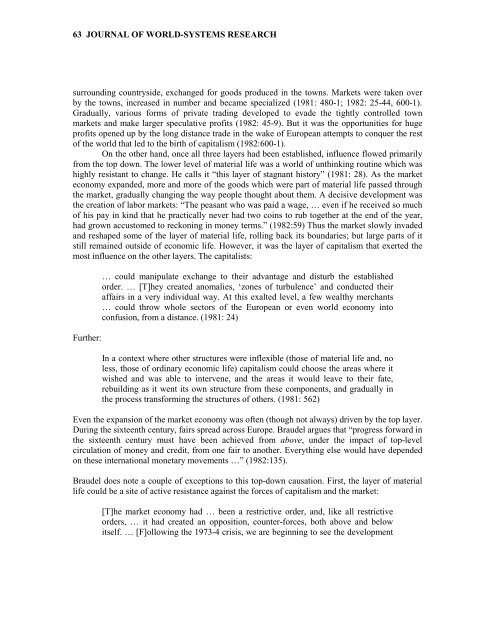Entire Volume 17 issue 1 - Journal of World-Systems Research ...
Entire Volume 17 issue 1 - Journal of World-Systems Research ...
Entire Volume 17 issue 1 - Journal of World-Systems Research ...
Create successful ePaper yourself
Turn your PDF publications into a flip-book with our unique Google optimized e-Paper software.
63 JOURNAL OF WORLD-SYSTEMS RESEARCH<br />
surrounding countryside, exchanged for goods produced in the towns. Markets were taken over<br />
by the towns, increased in number and became specialized (1981: 480-1; 1982: 25-44, 600-1).<br />
Gradually, various forms <strong>of</strong> private trading developed to evade the tightly controlled town<br />
markets and make larger speculative pr<strong>of</strong>its (1982: 45-9). But it was the opportunities for huge<br />
pr<strong>of</strong>its opened up by the long distance trade in the wake <strong>of</strong> European attempts to conquer the rest<br />
<strong>of</strong> the world that led to the birth <strong>of</strong> capitalism (1982:600-1).<br />
On the other hand, once all three layers had been established, influence flowed primarily<br />
from the top down. The lower level <strong>of</strong> material life was a world <strong>of</strong> unthinking routine which was<br />
highly resistant to change. He calls it “this layer <strong>of</strong> stagnant history” (1981: 28). As the market<br />
economy expanded, more and more <strong>of</strong> the goods which were part <strong>of</strong> material life passed through<br />
the market, gradually changing the way people thought about them. A decisive development was<br />
the creation <strong>of</strong> labor markets: “The peasant who was paid a wage, … even if he received so much<br />
<strong>of</strong> his pay in kind that he practically never had two coins to rub together at the end <strong>of</strong> the year,<br />
had grown accustomed to reckoning in money terms.” (1982:59) Thus the market slowly invaded<br />
and reshaped some <strong>of</strong> the layer <strong>of</strong> material life, rolling back its boundaries; but large parts <strong>of</strong> it<br />
still remained outside <strong>of</strong> economic life. However, it was the layer <strong>of</strong> capitalism that exerted the<br />
most influence on the other layers. The capitalists:<br />
Further:<br />
… could manipulate exchange to their advantage and disturb the established<br />
order. … [T]hey created anomalies, ‘zones <strong>of</strong> turbulence’ and conducted their<br />
affairs in a very individual way. At this exalted level, a few wealthy merchants<br />
… could throw whole sectors <strong>of</strong> the European or even world economy into<br />
confusion, from a distance. (1981: 24)<br />
In a context where other structures were inflexible (those <strong>of</strong> material life and, no<br />
less, those <strong>of</strong> ordinary economic life) capitalism could choose the areas where it<br />
wished and was able to intervene, and the areas it would leave to their fate,<br />
rebuilding as it went its own structure from these components, and gradually in<br />
the process transforming the structures <strong>of</strong> others. (1981: 562)<br />
Even the expansion <strong>of</strong> the market economy was <strong>of</strong>ten (though not always) driven by the top layer.<br />
During the sixteenth century, fairs spread across Europe. Braudel argues that “progress forward in<br />
the sixteenth century must have been achieved from above, under the impact <strong>of</strong> top-level<br />
circulation <strong>of</strong> money and credit, from one fair to another. Everything else would have depended<br />
on these international monetary movements …” (1982:135).<br />
Braudel does note a couple <strong>of</strong> exceptions to this top-down causation. First, the layer <strong>of</strong> material<br />
life could be a site <strong>of</strong> active resistance against the forces <strong>of</strong> capitalism and the market:<br />
[T]he market economy had … been a restrictive order, and, like all restrictive<br />
orders, … it had created an opposition, counter-forces, both above and below<br />
itself. … [F]ollowing the 1973-4 crisis, we are beginning to see the development





